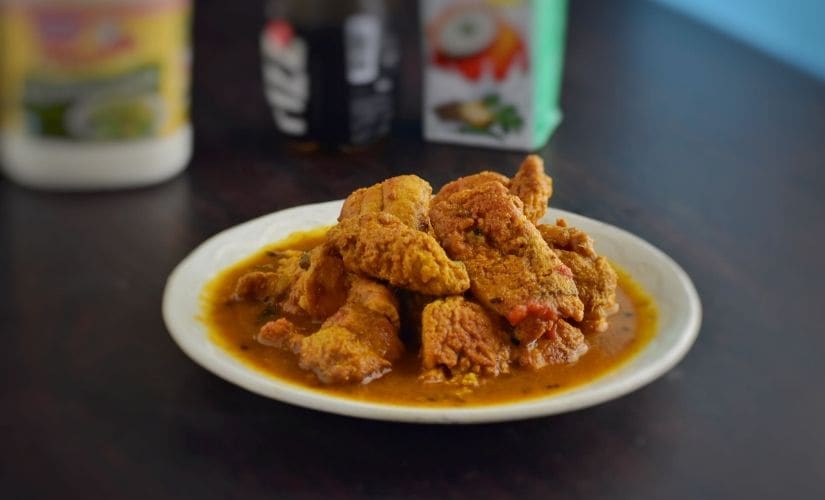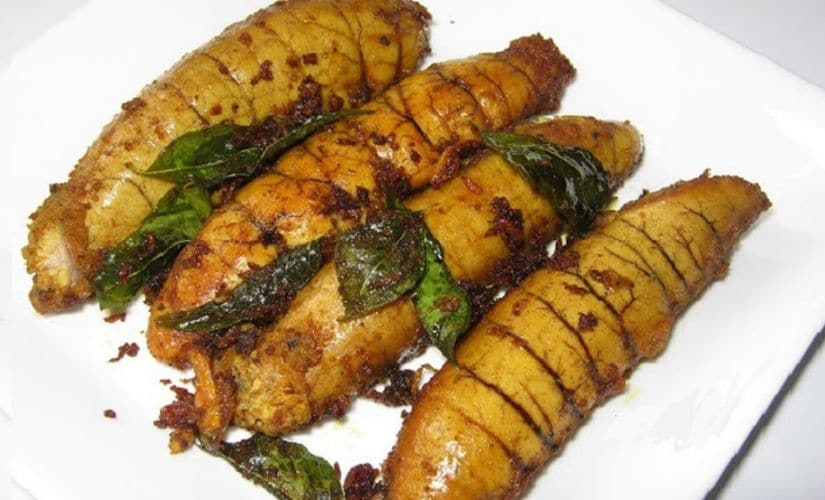Armed with an intent and the scent of memories, homemaker Seema Salgaonkar makes her way to the City Light (Gopi Tank) fish market in Mumbai, where she has tipped her regular fisherwoman to let her know when a fish is bearing eggs. For the west, it may be caviar, and in the far east it may go by the name ikura, but in India, this reasonably rare delicacy comes in myriad names and forms. The Parsis eat fish roe pickled in vinegar brine and call it ‘garabh nu achaar’, which roughly translates to pickle of the womb; they also have the ‘Sindhi aani masala’ or stir fried fish roe in caramelised onions and tomato sauce. On the other hand, Maharashtrians have their delectable ‘gaboli fry’ (semolina coated and shallow-fried fish roe), Bengalis have their ‘maachher deemer bora’ (fish roe fritters), Malayalis serve their fish roe cooked with coconut — ‘meen muttai varuthathu’, and the Telegu prepare it in a curry— ‘jana pulusu’. Clearly, the fish roe is nothing if not versatile, as is evident from these ethnic preparations steeped in culinary heritage of the various states.
The ‘aani ji bhaji’ made with roe is a Sunday delicacy in many Sindhi households during monsoons. So much is the love for the dish that a faux version named ‘besni tikki bhaji’ has been engineered for vegetarians, and for times when roe is unavailable. Poppy seeds are used to attain the same grainy texture, while gram flour mimics the shape. It’s a throwback to the past for many. “I used to eat it when my grandmother was around. It was simply delicious,” says Bengaluru-based businessman, CK Reddy, wistfully. It also evokes memories for some. “I spent a few childhood years in Mangalore where the fisherman would come to the door with the fresh catch of the day. Later, growing up in Mumbai and Pune, I accompanied my parents to the markets and over a period of time, could look at the bulge on the fish, with touch and feel, tell if it is carrying eggs,” recollects Praveen Shetty, executive chef at Conrad, Bengaluru. Chef Parimal Sawant from Mumbai’s InterContinental likes his roe home-cooked. “My grandmother in Ratnagiri would marinate the roe in spices, wrap it in banana leaf or foil and slow cook it on coal.”
Chef Regi Mathew from Chennai’s Kappa Chakka Kandhari restaurant, like any other Malayali, prefers his roe scrambled. He shares, “Malayalis eat ‘panajeen’, which is fish roe with an egg made into an omelette, or scramble with grated coconut, to reduce the extra fishy flavour. ‘Meen mutta porichaddu’ of sardine eggs is my personal favourite. I ignore the eggs and just make a roe scramble with extra spices and curry leaves.” He says it’s important to eat fresh fish eggs and not the frozen variety.

Talking about ‘garabh nu achaar’, food anthropologist Kurush Dalal asks you to “forget curries”. “We Parsis can make pickles out of anything. It was the advent of vinegar that changed the pickling business forever. With vinegar, items that couldn’t be pickled earlier also started to be pickled. Fish roe can get prohibitively expensive and has to be eaten fresh or it stinks. Thus, it makes sense to pickle the extra roe,” says the man who’s also the proprietor of a Parsi catering firm in Mumbai. “The most widely accepted way of eating roe is fried at parties with drinks,” he adds.
Ananya Banerjee, a chef who crusades for lesser-known Oriya and Bengali dishes through her books, TV shows and videos, says: “From using vegetable skin and fibrous stems in our dishes, to using the whole fish including head, tail, stomach and intestine, zero waste cooking is an intrinsic part of our (Bengali) cuisine. Fish roe is a true delicacy for us. ‘Maachher deemer bora’ (roe fritters), ‘maachher deemer jhuri bhaja’ (thin-and-crispy fried roe), ‘maachher deemer jhal’ (roe in spicy curry), ‘maachher deemer tok’ (tangy roe curry), are our absolute favourites.”
To make ‘maachher deemer bora’, the fish roe has to be flavoured with ginger and garlic, coated in gram flour, and deep fried like fritters. Banerjee mentions how Bengalis love all things fish, but have a special place in their hearts for the queen fish, ilish’ or hilsa. It goes by the name ‘palla’ among Sindhis and Maharashtrians, while the Parsis call it ‘bhing’. Pomfret, seer (surmai), rohu, sardines — all have roes that are consumed. “Mackerel fish roe has a very typical flavour which is not liked by many. I like seer and halwa (Black pomfret) roes too,” Sawant says.

Shetty shares some tips for those wanting to cook fish roe. “The bigger the fish, the more delicate its egg is. In that case you only coat it with spices and gently shallow fry it. If it breaks, it disintegrates. Roe of the smaller fish are sturdier, to which you can add onion, tomato and cook it the way you like.” While in the west fish roe is consumed mostly raw, Indians like theirs cooked.
However, every food comes with its myths, adding to the rich repertoire of culinary lore. “My mother always told me not to eat madmal roe. Madmal is ‘pink pearl’ in English, and is believed to look like a newly married bride. Hence, we don’t eat it,” Shetty mentions.
Undeniably, a community’s food offers one of the biggest windows into its culture. Seema Salgaonkar talks about how anyone with roots in the coastal regions is likely to know about fish roe. “Goud Saraswat Brahmins and Chandraseniya Kayastha Prabhu (predominantly Maharashtrian communities) are hardcore fish eaters, and they will surely know about this fading delicacy.”
On being asked to elaborate on the “fading” aspect, she explains: “My grandfather, my father, and now I have been buying fish from the same fisherwoman in City Light market. Her children are not in the business, they are all educated and doing other jobs. These fisherwomen get fresh fish off the boat from the docks. The stuff at supermarkets is just not the same.”
Naturally, Salgaonkar’s fisherwoman unmistakably rings her every time fresh roe arrives. “I have told her I will pay anything. My kids and I love it so much. Two kidney shaped fish roes as big as a size of a palm, and sometimes bigger, cost anywhere between Rs 1,000 to Rs 1,500.” She shares how ‘gaboli fry’ is her favourite roe preparation — the roe is cleaned gently, steamed, cut into pieces (sometimes coated in semolina) and shallow fried.
“You know, some restaurants like Gajalee, Jay Hind, Chaitanya at Prabha Devi, and Mohammad Ali Road, serve it when in season,” Salgaonkar tips off, adding that “after Rakshabandhan (full-moon), fishing resumes, and there is time and process for the roe to develop. It’s available till November.” For fish roe, every state has its own banning period, depending on its availability and production.
Many restaurants in Mumbai mix it with bell peppers and onion, and serve it like ‘bhel’ as a starter — a dish customers seem to have taken a liking to.
But fish roe largely garners only extreme reactions — while some abstain from eating it, its lovers can’t seem to have their fill. However, it is only during breeding season that fish eggs are available, and should therefore be consumed with care. “Bengalis don’t subscribe to anything that stops them from eating fish, but I also believe it should be eaten within limits,” says Banerjee about her fish-loving community.

Kurush Dalal believes fish roe is slowly disappearing from Indian dinner tables. “Earlier, every family had a grandmother or an aunt who would make it here and there, and now I know of only one Parsi Zinobia Shroff in Mumbai who makes ‘garabh nu achaar’ commercially. It is also an acquired taste and not always commercially available,” he rues. But Chef Mathew remains optimistic. He feels youngsters from coastal communities still love fish roe and cook it quite often, “especially in monsoons when its available in abundance.”
Abhishek Tulaskar of Vah Malvan, a coastal Maharashtrian restaurant in Kalyan, says that they “get requests for fish roe” from guests who love it. “Those who haven’t eaten it or haven’t taken a liking to it actually detest it.” But Tulaskar also adds a word of caution: “Many do not know that it’s a rich dish. One of our regular guests did not visit us for a while and when he did, he said he had a bad case of gout and could not walk for a few days. Even though the guest loved gaboli, he vowed never to eat it again.”
Dalal confirms that it is “high in protein and other essential nutritional elements.” “You realise it is life sustaining, where the young are going be nurtured, and hence, (it’s) high on nutrition,” he says, reminding one to thank the few good souls who’ve held on to culinary heritages, one delicious dish at a time.







